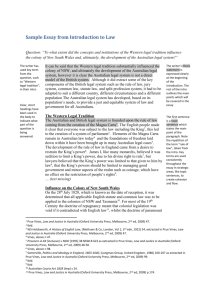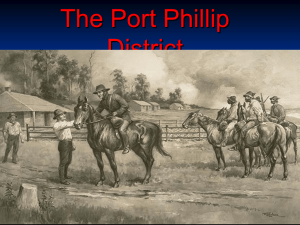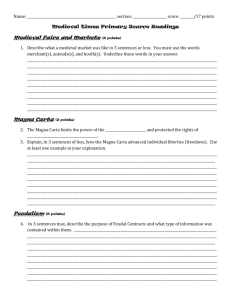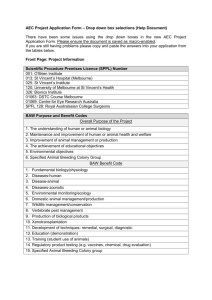`Cues` for Law Study Writing Academically: Using Outside Sources
advertisement
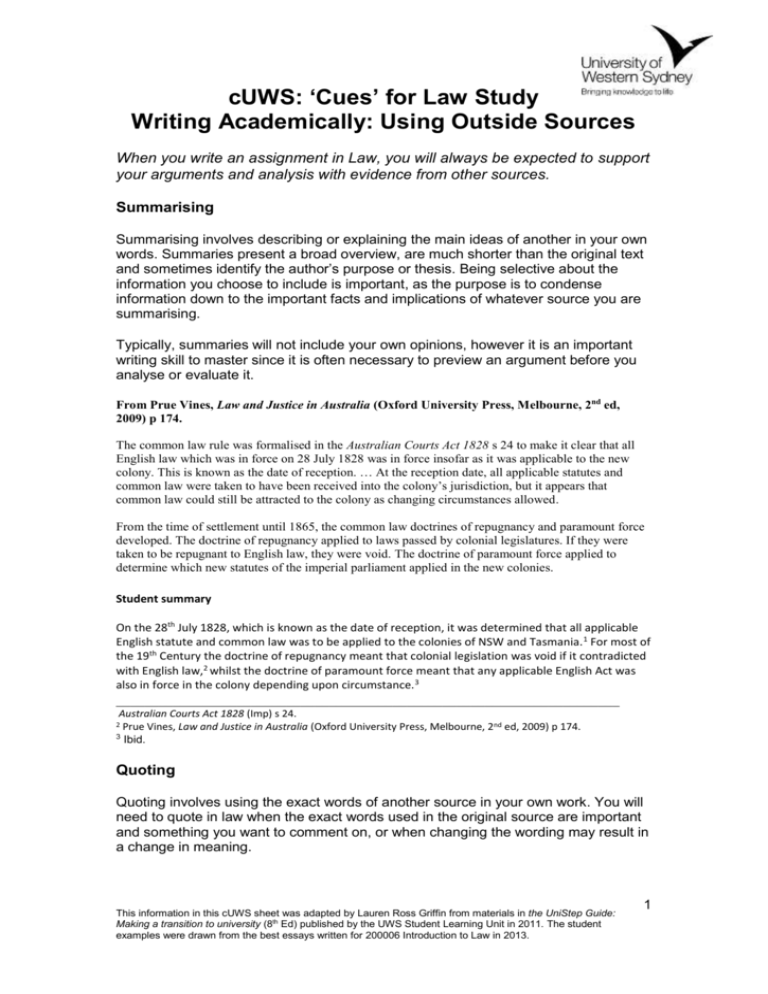
cUWS: ‘Cues’ for Law Study Writing Academically: Using Outside Sources When you write an assignment in Law, you will always be expected to support your arguments and analysis with evidence from other sources. Summarising Summarising involves describing or explaining the main ideas of another in your own words. Summaries present a broad overview, are much shorter than the original text and sometimes identify the author’s purpose or thesis. Being selective about the information you choose to include is important, as the purpose is to condense information down to the important facts and implications of whatever source you are summarising. Typically, summaries will not include your own opinions, however it is an important writing skill to master since it is often necessary to preview an argument before you analyse or evaluate it. From Prue Vines, Law and Justice in Australia (Oxford University Press, Melbourne, 2nd ed, 2009) p 174. The common law rule was formalised in the Australian Courts Act 1828 s 24 to make it clear that all English law which was in force on 28 July 1828 was in force insofar as it was applicable to the new colony. This is known as the date of reception. … At the reception date, all applicable statutes and common law were taken to have been received into the colony’s jurisdiction, but it appears that common law could still be attracted to the colony as changing circumstances allowed. From the time of settlement until 1865, the common law doctrines of repugnancy and paramount force developed. The doctrine of repugnancy applied to laws passed by colonial legislatures. If they were taken to be repugnant to English law, they were void. The doctrine of paramount force applied to determine which new statutes of the imperial parliament applied in the new colonies. Student summary On the 28th July 1828, which is known as the date of reception, it was determined that all applicable English statute and common law was to be applied to the colonies of NSW and Tasmania. 1 For most of the 19th Century the doctrine of repugnancy meant that colonial legislation was void if it contradicted with English law,2 whilst the doctrine of paramount force meant that any applicable English Act was also in force in the colony depending upon circumstance. 3 _______________________________________________________________________ Australian Courts Act 1828 (Imp) s 24. Prue Vines, Law and Justice in Australia (Oxford University Press, Melbourne, 2nd ed, 2009) p 174. 3 Ibid. 2 Quoting Quoting involves using the exact words of another source in your own work. You will need to quote in law when the exact words used in the original source are important and something you want to comment on, or when changing the wording may result in a change in meaning. This information in this cUWS sheet was adapted by Lauren Ross Griffin from materials in the UniStep Guide: Making a transition to university (8th Ed) published by the UWS Student Learning Unit in 2011. The student examples were drawn from the best essays written for 200006 Introduction to Law in 2013. 1 When using short quotes, you will need to encase the exact words you have borrowed in quotations marks and integrate the quote seamlessly into your own sentence so that the grammar of the sentence flows smoothly. From Prue Vines, Law and Justice in Australia (Oxford University Press, Melbourne, 2nd ed, 2009) p 174. Sir William Blackstone (1723–80) was the foremost legal scholar of the eighteenth century, and his Commentaries on the Laws of England was well known to the colonists of New South Wales. One of his well-known statements was:1 For it is held, that if an uninhabited country be discovered and planted by English subjects, all the English laws are immediately there in force. For as the law is the birthright of every subject, so wherever they go they carry their laws with them. In this chapter, we examine the way the British people who came to the colony of New South Wales (which covered all the eastern half of Australia) used the heritage of ideas which had been used in the English Civil War and Glorious Revolution to change their colony from a jail to a free and selfgoverning entity. ______________________________ 1 Sir W Blackstone, Commentaries on the Laws of England, Vol 1, 104-5. Student integrated quotation Blackstone noted,4 “Wherever they [English subjects] go they carry their laws with them.” During the initial settlements—from 1786 and up until the separation of states—, the colony of New South Wales maintained a legal set up extremely similar to that of the British; however this gradually, and in some cases rapidly, changed over time to become Australia’s own unique legal system. __________________________________________ 4 Sir W Blackstone, Commentaries on the Laws of England, Vol 1, 104-5 extracted in Prue Vines, Law and Justice in Australia: Foundations of the Legal System (Oxford University Press, 2nd Ed, 2009) 155. Paraphrasing Paraphrasing involves explaining the ideas of another in your own words. It is usually preferred over direct quoting as a method for incorporating outside sources into your writing, because through using you own words to explain ideas, you show your own understanding of those. When paraphrasing you need to substantially change the wording of the original text, and not simply rearrange the grammatical structure of the sentence or substitute a couple of words. It is also important that you acknowledge the source of the idea. Ideas which are not adequately paraphrased are actually a form of plagiarism, as you are using the words of another without acknowledging that they are not your own. The following example shows an extract from a piece of text, and examples of effective and inadequate paraphrasing. From Prue Vines, Law and Justice in Australia (Oxford University Press, Melbourne, 2nd ed, 2009) p 162. From 1788 to 1823, the colony experienced personal rule of the governor, limited only by directions from Britain through the Secretary of State for the colonies. Since such directions could take six months to arrive, the governor’s powers were practically unlimited in respect of many matters. … Thus in many ways within the colony the governor was in a similar position to the position the kings of This information in this cUWS sheet was adapted by Lauren Ross Griffin from materials in the UniStep Guide: Making a transition to university (8th Ed) published by the UWS Student Learning Unit in 2011. The student examples were drawn from the best essays written for 200006 Introduction to Law in 2013. 2 England had been in before 1649; and in some ways they were even more powerful, since there was not even a rudimentary legislature to counter them. Ineffective student paraphrase: a few words substituted or omitted or rearranged, source not acknowledged and direct quotes not indicated with quotation marks. The highlighted text would show on Turnitin as coming from another source. This would be plagiarism. From 1788 the colony of NSW experienced almost unlimited rule of the governor because directions from England could take six months to arrive. This meant the governor was in a similar position to the position the kings of England had been in before 1649. Sometimes they were even more powerful, because there was no legislature to stop them. Effective student paraphrase Governor Phillip’s power over the colony was seen as either equal or greater than the unlimited prerogative of kings’ pre-1649.5 Governors were essentially the only administrators of the colonial legal system, as the colony had no direct contact with the British parliament or the King. However, this ultimate prerogative was later divided between different sections of the legal system—mainly the courts and Parliament.5 _______________________________________________________ 5 6 Vines, above n 11, 163. Ibid. Synthesising Synthesis refers to the process of binding together information from a variety of different sources which might include cases, articles or books, to create an overall picture of a situation. Typically when synthesising you will summarise information from a variety of sources and then explain how the findings from these sources interact or affect one another to develop your own argument. The process of synthesis starts at the notetaking stage, and can be made easier by “chunking” your notes, or organising them by themes rather than by order in which you read the sources. This is particularly easy with word processing. To chunk notes: 1. Analyse your question or task before you begin reading and think about the major themes or ideas which you need to discuss. Use these themes as headings for your notes. 2. As you read, write your notes according to these headings. 3. Afterwards, examine your notes for instances where different sources either build upon, or disagree with each other. From Prue Vines, Law and Justice in Australia (Oxford University Press, Melbourne, 2nd ed, 2009) 47. The [Magna Carta] was a foundation of the English constitution and remains part of the law in all the Australian jurisdictions. There are clauses in the charter which limit the arbitrary use of power, and clauses relating to the court system. For example, the Court of Common Pleas was to be held in a fixed place. But most important of all, the Magna Carta demonstrates that the king could be restrained. Holdsworth observes5 ‘[T]he gaining of Magna Carta closes one period in the history of English law and begins another. It closes the period during which the law is developed by the power of the crown alone, and it begins the period which will end in the establishment of a Parliament, with power to take This information in this cUWS sheet was adapted by Lauren Ross Griffin from materials in the UniStep Guide: Making a transition to university (8th Ed) published by the UWS Student Learning Unit in 2011. The student examples were drawn from the best essays written for 200006 Introduction to Law in 2013. 3 some share in the making and development of the law’. Magna Carta is a document whose legendary qualities probably far transcend its original _______________________ 5 W S Holdsworth, A History of English Law, Vol 1, 3rd edn, Methuen & Co, London, 1922, p 54. Prisoners A–XX (inclusive) v NSW (1995) 38 NSWLR 622 Court of Appeal NSW … The appellants claim to be entitled to rely upon the first sentence of Chapter 39 in the 1215 version of the Magna Carta, in support of all aspects of their proceedings. According to McKechnie at 376–7, … The chapter forbade execution before judgment and insisted that every judgment must be delivered by the accused man’s ‘equals’ and that no free man should be punished except ‘in accordance with the law of the land’. Both 17th century English lawyers, led by Sir Edward Coke, and American lawyers, reinstated and increased the importance of Magna Carta as a declaration of supposed fundamental principles of common law; see generally Jago v Judges of District Court of New South Wales (1988) 12 NSWLR 558 at 574 per Samuels JA and in the High Court Jago v District Court of New South Wales (1989) 168 CLR 23 at 62. Student synthesis The Australian and British legal system is founded upon the rule of law which can be traced back to the Magna Carta.7 The English people made it clear in 1215 that everyone was subject to the law including the King.8 This ultimately led to the creation of a system of parliament.9 Elements of the Magna Carta remain in Australian law today and the foundations of freedom laid down within it have been held by many Australian legal cases to still be part of Australian law.10 ____________________________________ 7 Prue Vines, Law and Justice in Australia (Oxford University Press, Melbourne, 2nd ed, 2009) 47. 8 Ibid. WS Holdsworth, A History of English Law, (Methuen & Co, London, Vol 1, 3rd edn, 1922) 54, extracted in Prue Vines, Law and Justice in Australia (Oxford University Press, Melbourne, 2nd ed, 2009) 47. 10 Prisoners A-XX (inclusive) v NSW [1995] 38 NSWLR 622 as extracted in Prue Vines, Law and Justice in Australia (Oxford University Press, Melbourne, 2nd ed, 2009) 48-50. 9 Quotations, Paraphrases and Summaries Contrasted Summarising Paraphrasing Quoting Made up exclusively of the main ideas of a passage written in your own words. Passages from a source written in your own words. Segment from a source, written word for word as it appears in the original text. Presents a broad overview, so is much shorter than the original text. Changes the words of a text, but retains and fully communicates the original meaning. Appears between quotation marks. May be longer than the original text. Must be referenced to the original source. Must be referenced to the original source. Must be referenced to the original source. This information in this cUWS sheet was adapted by Lauren Ross Griffin from materials in the UniStep Guide: Making a transition to university (8th Ed) published by the UWS Student Learning Unit in 2011. The student examples were drawn from the best essays written for 200006 Introduction to Law in 2013. 4
